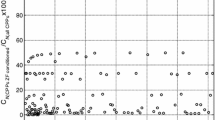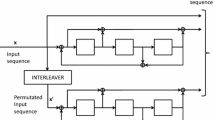Abstract
Two search methods of quadratic permutation polynomials (QPP) for interleavers used in turbo codes are proposed. These methods lead to larger minimum distances and smaller multiplicities compared to the interleavers proposed by Takeshita in (Takeshita 1). The search is accomplished in a limited set of polynomials, that is, those for which the spreading factor and Ω′ metric are maximum. The minimum distance is computed by means of Garello algorithm in which the maximum weight of information sequence is 3 or 4, reducing the search time. The results obtained for two particular component codes show the efficiency of the proposed methods.

Similar content being viewed by others
References
Takeshita YO (2007) Permutation polynomial interleavers: an algebraic-geometric perspective. IEEE Trans Inf Theory 32(6):2116–2132
Sun J, Takeshita YO (2005) Interleavers for turbo codes using permutation polynomial over integers rings. IEEE Trans Inf Theory 51(1):101–119
Takeshita YO (2006) Maximum contention-free interleavers and permutation polynomials over integers rings. IEEE Trans Inf Theory 52(3):1249–1253
Ryu J, Takeshita YO (2006) On quadratic inverses for quadratic permutation polynomials over integers rings. IEEE Trans Inf Theory 52(3):1254–1260
Crozier S (2000) New High-spread high-distance interleavers for turbo-codes, 20th Biennial Symposium on Communications. Kingston, Ontario, Canada, pp 3–7
Lee CY (1958) Some properties of nonbinary error-correcting codes. IRE Transactions on Information Theory IT-4(2):77–82
Heegard C, Wicker SB (1999) Turbo coding. Kluwer, Dordrecht, The Netherlands
Trifina L, Munteanu V, Tărniceriu D (2006) Welch-costas interleaver with cyclic shifts on groups of elements. Electron Lett 42(24):1413–1415
Divsalar D, Pollara F (1995) Turbo codes for PCS applications. Proceedings of ICC 1995, Seattle, WA, pp 54–59
Garello R, Pierleoni P, Benedetto S (2001) Computing the free distance of turbo codes and serially concatenated codes with interleavers: algorithms and applications. IEEE J Sel Areas Commun 19(5):800–812
The Turbo Code Minimum Distance Algorithm. http://www.tlc.polito.it/garello/turbodistance/turbodistance.html
Rosnes E, Takeshita YO (2006) Optimum distance quadratic permutation polynomial-based interleavers for turbo codes. Proc. IEEE International Symposium on Information Theory, Seattle, USA, pp 1988–1992
Guinand P, Lodge J (1994) Trellis termination for turbo encoders. Proc. 17th Biennial Symposium on Communications, Queen’s University, Kingston, Canada, pp 389–392
Trifina L, Balta HG (2005) Decresing of the turbo MAP decoding time using an iteration stopping criterion. Proc. IEEE International Symposium on Signals, Circuits and Systems, 2005, Iasi, pp 371–374
Author information
Authors and Affiliations
Corresponding author
Rights and permissions
About this article
Cite this article
Tarniceriu, D., Trifina, L. & Munteanu, V. About minimum distance for QPP interleavers. Ann. Telecommun. 64, 745 (2009). https://doi.org/10.1007/s12243-009-0120-3
Received:
Accepted:
Published:
DOI: https://doi.org/10.1007/s12243-009-0120-3




